Why Cant I Wrap Clip Art in a Table Publisher
Lesson 5: Working with Shapes and Objects
/en/publisher2010/working-with-text/content/
Introduction
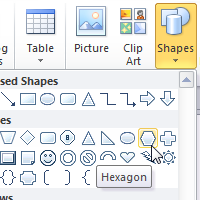
In Publisher, the components of any publication are called objects. You've already worked with text boxes, which are one type of object. Publisher offers decorative objects as well, including shapes and Edifice Blocks.
In this lesson, you lot'll learn how to create and modify shapes and Building Blocks. You'll besides learn how to marshal, group, and arrange objects of all types.
Working with shapes
Using shapes and objects is an easy style add graphic blueprint elements to your publication. While yous may not need shapes in every publication y'all create, they can add visual appeal.
To insert a shape:
- Select the Insert tab, then locate the Illustrations group.
- Click the Shapes drop-down control.
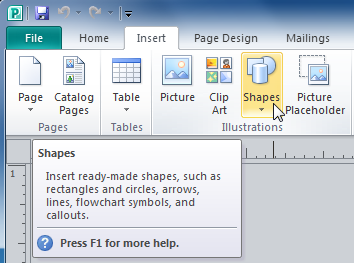 The Shapes drop-down command
The Shapes drop-down command - Select a shape from the drop-down carte du jour.
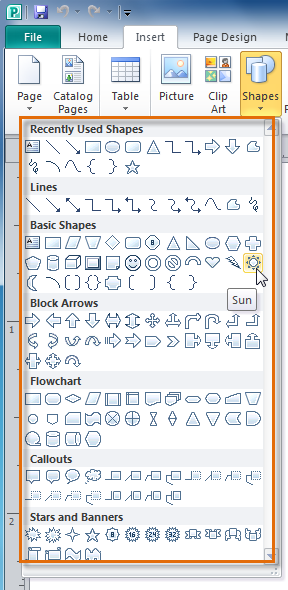 Selecting a shape
Selecting a shape - Click and drag the mouse until the shape is the desired size.
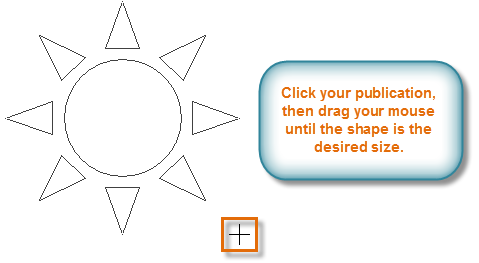 Clicking and dragging to create a shape
Clicking and dragging to create a shape - Release the mouse button. The shape will exist added to your publication.
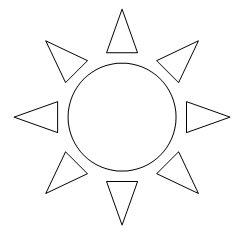 The added shape
The added shape
To resize a shape:
- Select the shape.
- Click and elevate one of the sizing handles on the corners and sides of the text box until information technology is the desired size. Y'all can:
- Elevate the top or lesser sizing handles to modify shape superlative
- Drag the side handles to modify shape width
- Drag the corner handles to modify height and width at the same time
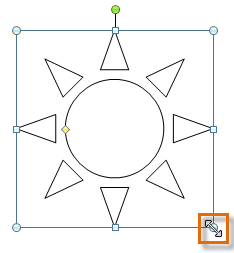 Resizing a shape
Resizing a shape - To rotate the shape, click and drag the green handle.
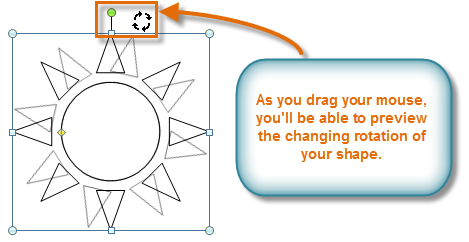 Rotating a shape
Rotating a shape - Some shapes likewise take one or more yellow handles that can be used to modify the shape. For example, with this lord's day shape you tin can adjust the diameter of the center circle and the length of the points.
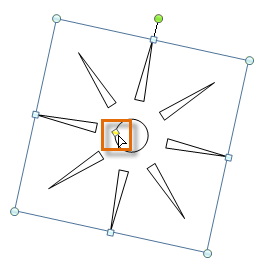 Modifying a shape with the xanthous handle
Modifying a shape with the xanthous handle
If you hold down the shift key while resizing a shape, the shape volition go along its proportions instead of getting stretched out. For example, if you hold downward the shift cardinal while you resize a square, the last shape will remain a perfect square with four equal sides.
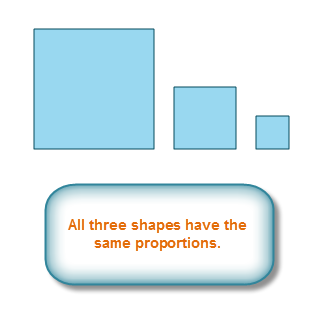 Shapes that have been resized with the shift primal
Shapes that have been resized with the shift primal
Modifying shapes
To modify to a different shape:
- Select the shape, then click the Format tab and locate the Shape Styles group.
- Click the Change Shape drop-down command.
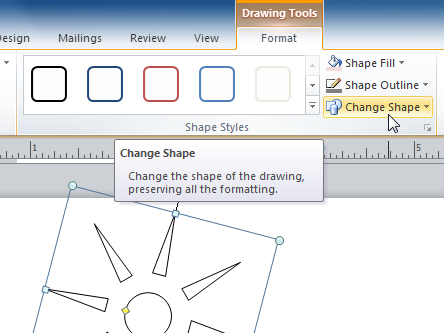 The Change Shape drop-down command
The Change Shape drop-down command - A driblet-down list will appear. Select the desired shape.
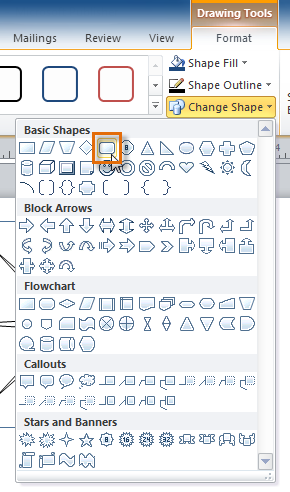 Selecting a new shape
Selecting a new shape - The shape will exist changed.
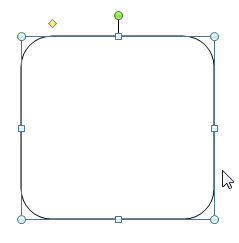 The changed shape
The changed shape
To change shape style:
- Select the shape, so click the Format tab and locate the Shape Styles group.
- Click the More Shape Styles drop-downwardly arrow.
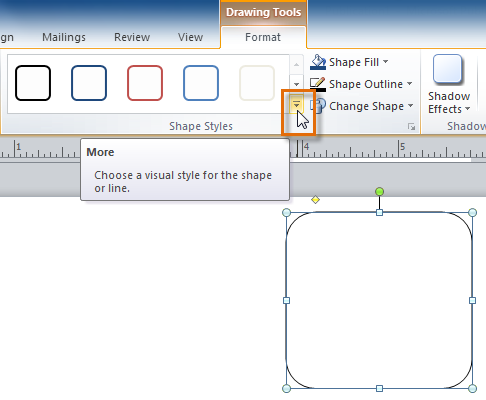 The More Shape Styles drop-down pointer
The More Shape Styles drop-down pointer - A drop-downwardly list of styles will appear. Move your cursor over the styles to see a live preview of the style in your publication, so select the desired style.
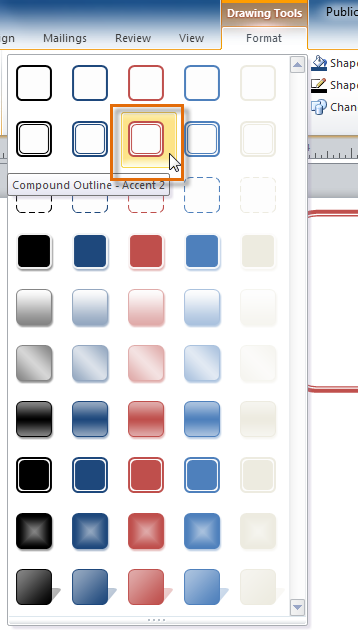 Selecting and previewing a shape manner
Selecting and previewing a shape manner - The way will be applied to the shape.
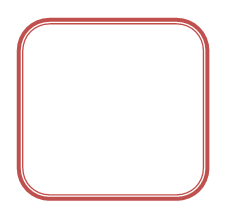 The shape, with the style practical
The shape, with the style practical
To change the shape fill color:
- Select the shape, then click the Format tab and locate the Shape Styles group.
- Click the Shape Make full drop-down command.
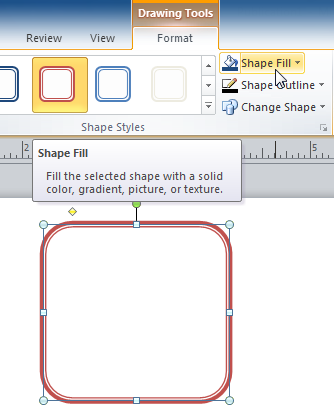 The Shape Make full drop-downwardly control
The Shape Make full drop-downwardly control - A drop-down list of colors will announced. Select the desired fill colour from the list. You can also choose No Fill to remove the fill from your shape or More than Fill Colors to select a custom color.
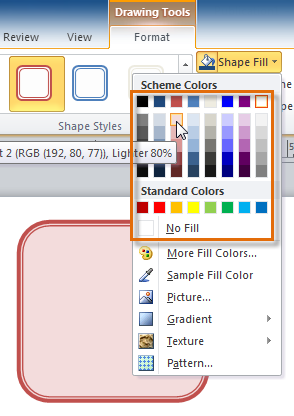 Shape fill options
Shape fill options - The new fill color will be applied.
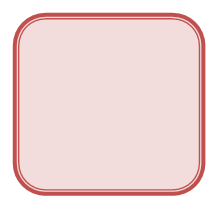 The recolored shape
The recolored shape
To change the shape outline:
- Select the shape, then click the Format tab and locate the Shape Styles grouping.
- Click the Shape Outline drop-down command.
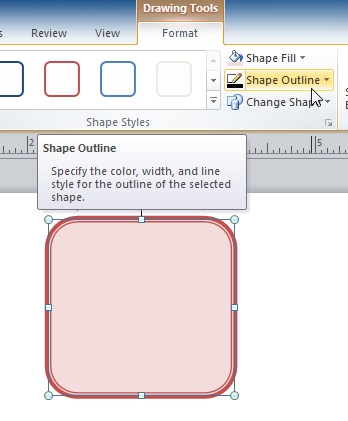 The Shape Outline drib-down command
The Shape Outline drib-down command - A drop-down list of options will appear. Select the desired outline color from the list. You tin can besides choose No Outline to remove the outline from your shape or More Outline Colors to select a custom color.
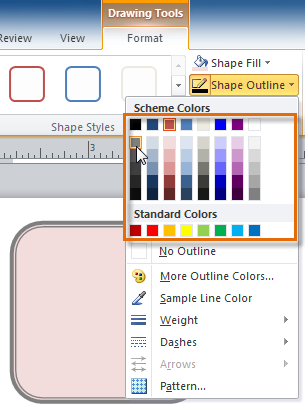 Selecting and previewing an outline color
Selecting and previewing an outline color - If desired, further modify your shape outline by irresolute the outline's weight (thickness) and whether or not information technology is a dashed line.
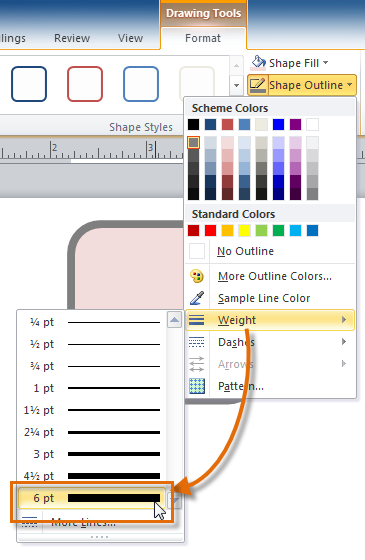 Applying a thicker outline
Applying a thicker outline - The shape outline will be modified.
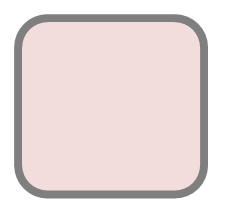 The updated shape
The updated shape
To add a shadow:
- Select the shape, then click the Format tab and locate the Shadow Effects grouping.
- Click the Shadow Furnishings drop-downward command.
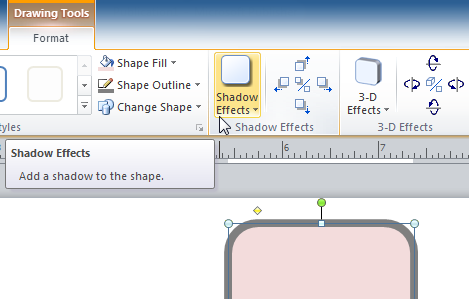 The Shadow Effects drib-down command
The Shadow Effects drib-down command - A drib-down bill of fare with a listing of shadow choices will appear. Motility your mouse over a shadow event to see a live preview of it in your publication.
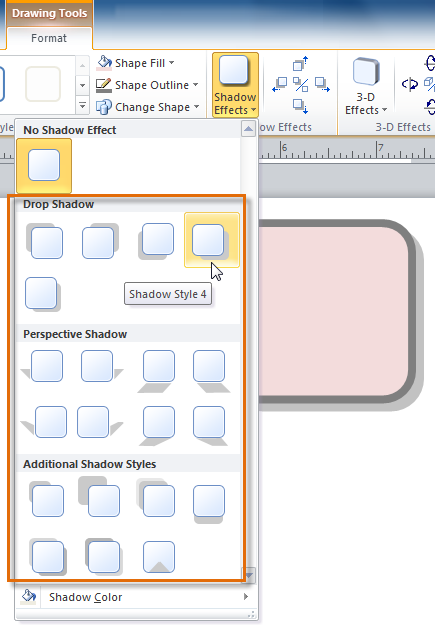 Selecting and previewing a shadow upshot
Selecting and previewing a shadow upshot - Click the desired shadow effect to apply information technology to your shape.
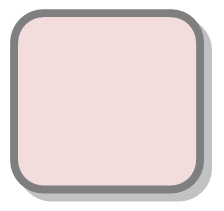 The shape, now with a shadow
The shape, now with a shadow
Yous can select Shadow Options from the drop-downwardly menu and click the Color button to select a different shadow colour for your shape.
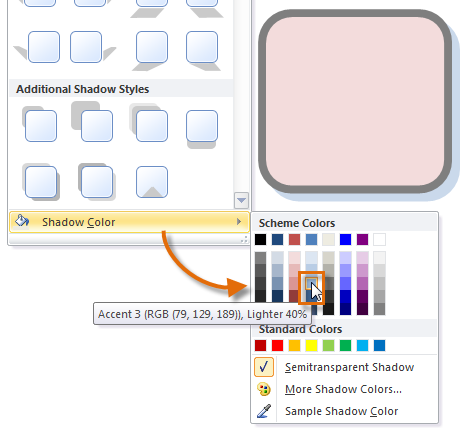 Applying a different shadow color
Applying a different shadow color
Working with Building Blocks
Edifice Blocks are another type of object in Publisher. They commonly contain some combination of text, shapes, and images, and they're meant to heighten the appearance of your publication. Once y'all insert a Building Block, you can alter information technology to adapt your needs.
Types of Building Blocks:
There are iv types of Building Blocks:
- Page parts, which are stylized placeholders for your images and text
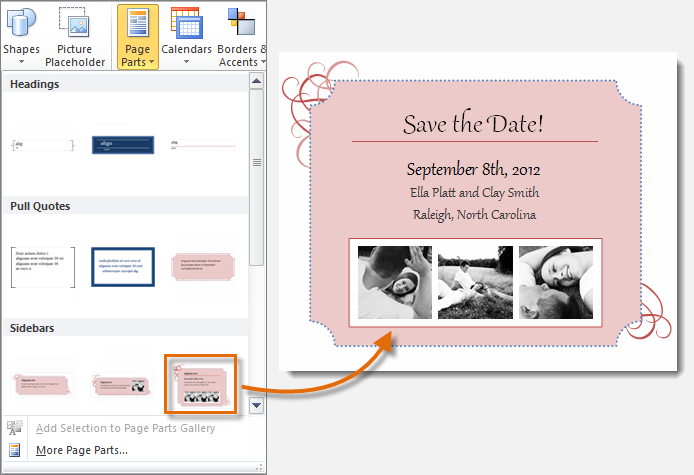 Folio parts
Folio parts - Calendars
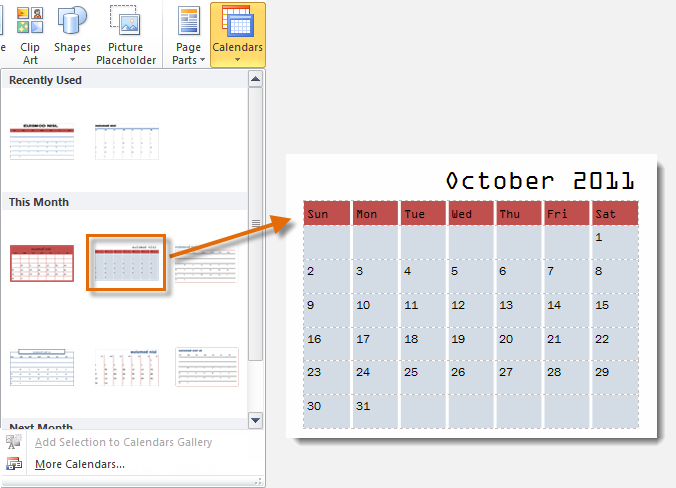 Calendars
Calendars - Borders & Accents
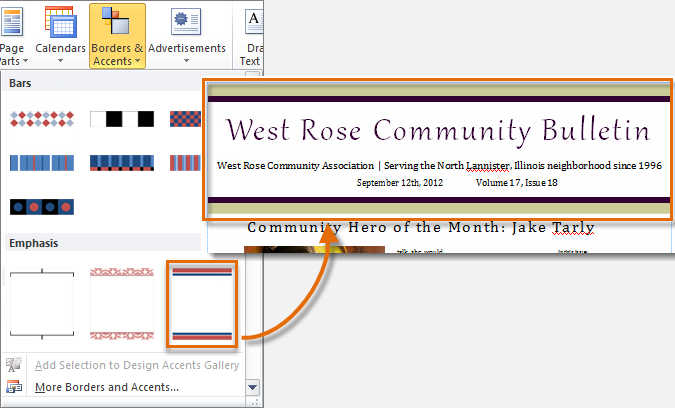 Borders & Accents
Borders & Accents - Advertisements
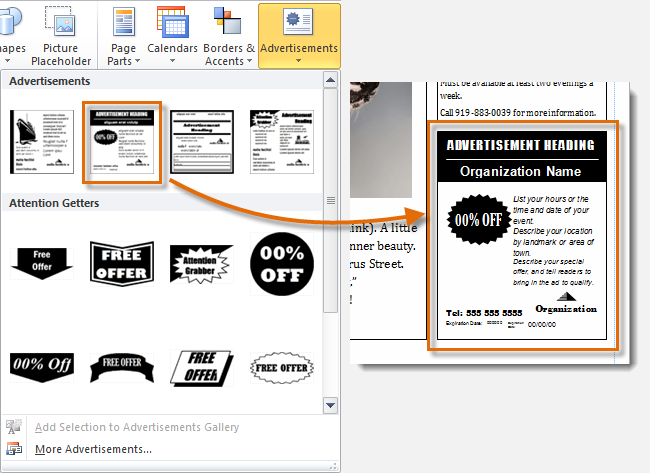 Advertisements
Advertisements
To insert a Building Block:
- Select the Insert tab, so locate the Building Blocks group.
- Click ane of the four Edifice Block drop-downwardly commands.
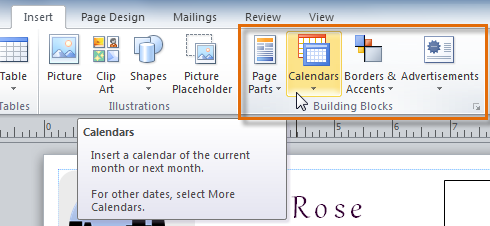 The Building Blocks group of commands
The Building Blocks group of commands - A driblet-downwardly menu volition announced with Building Block styles and options. Select the desired Edifice Block.
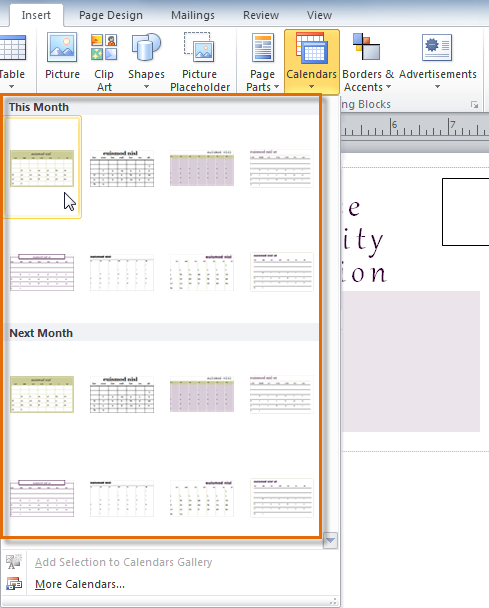 Building Blocks options
Building Blocks options - The Building Cake will be inserted.
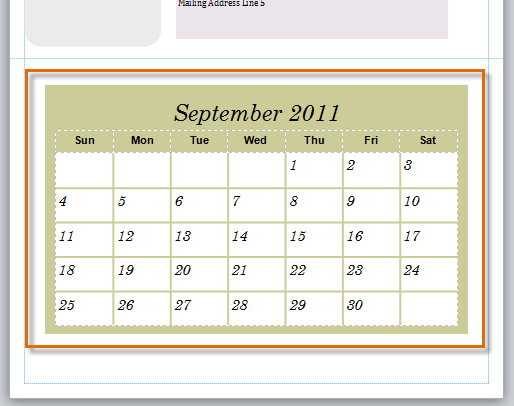 The inserted Building Block
The inserted Building Block - If desired, modify the Building Cake's text and formatting until you are satisfied with its appearance.
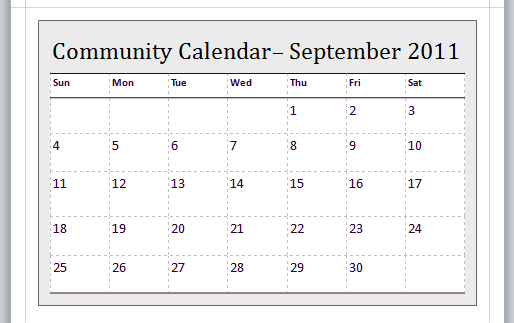 The modified edifice block
The modified edifice block
Arranging objects
Publisher offers a number of tools to aid you lot arrange and social club your objects. These tools piece of work for whatsoever object, and they tin help yous lay out your pages rapidly and precisely.
Aligning
You tin click and drag objects to align them manually, merely this can be difficult and time consuming. Publisher includes several commands that allow yous to marshal your objects chop-chop and precisely. Objects tin be aligned to each other or to the page.
To align two or more objects:
- Click and drag your mouse to form a option box effectually the objects you want to align. All of the objects will now take sizing handles to show that they are selected.
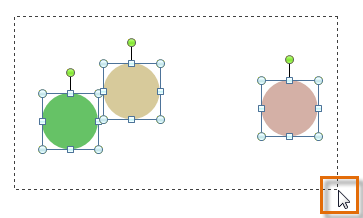 Selecting multiple objects
Selecting multiple objects - Click the Format tab, then locate the Conform group.
- Click the Align drib-down command.
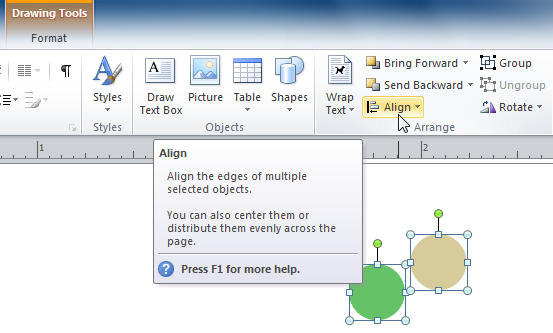 The Align drop-down command
The Align drop-down command - Select ane of the six alignment options.
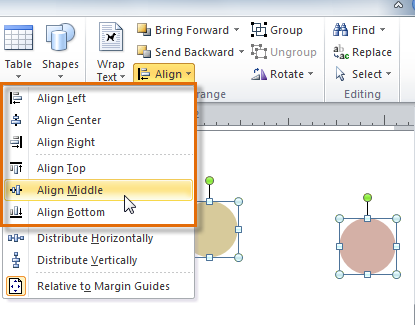 Alignment options
Alignment options - The objects will marshal to each other based on the pick you have selected.
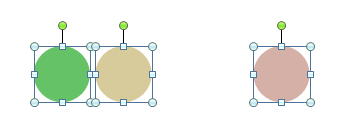 The objects are now aligned
The objects are now aligned
Another fashion to select multiple objects at once is to simply agree down the shift key and click each object y'all wish to select.
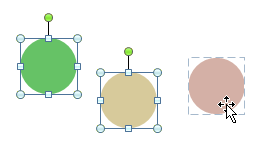 Selecting multiple objects at one time
Selecting multiple objects at one time
To align objects to the page:
- Select the object or objects you want to align.
- Click the Format tab, then locate the Arrange group.
- Click the Align drop-downwards control.
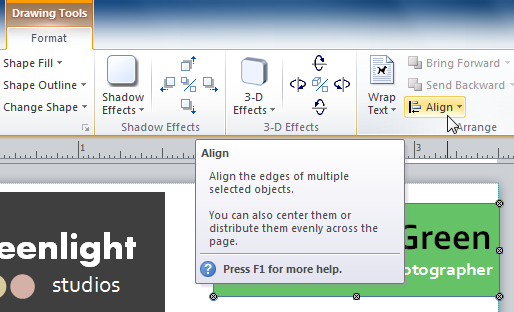 The Align drop-down control
The Align drop-down control - From the drop-down listing that appears, select Relative to Margin Guides.
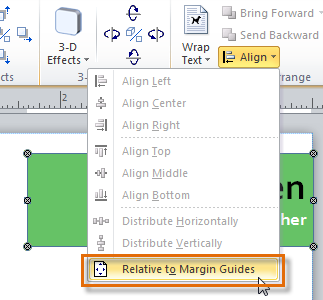 Choosing to align to the page margins
Choosing to align to the page margins - Select i of the half-dozen alignment options.
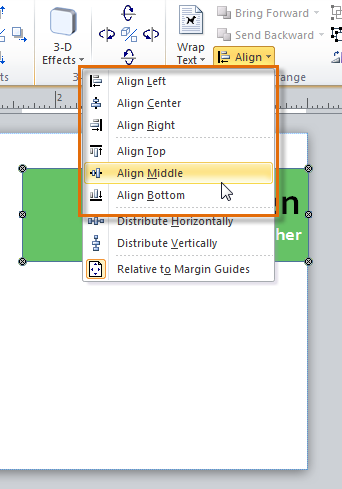 Alignment options
Alignment options - The objects volition marshal to the page based on the option you have selected.
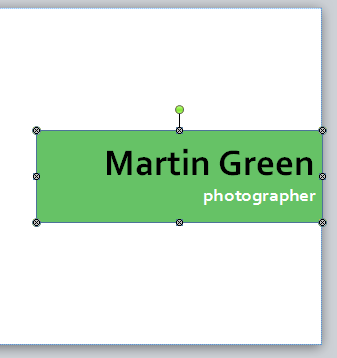 The object, now aligned to the middle of the folio
The object, now aligned to the middle of the folio
Distributing objects evenly
If you take arranged objects in a row or column, you may desire them to exist an equal distance from one another for a neater advent. You tin can practise this by distributing the objects horizontally or vertically.
To distribute objects:
- Select the objects you want to align.
- Click the Format tab, then locate the Arrange grouping.
- Click the Marshal drop-down command.
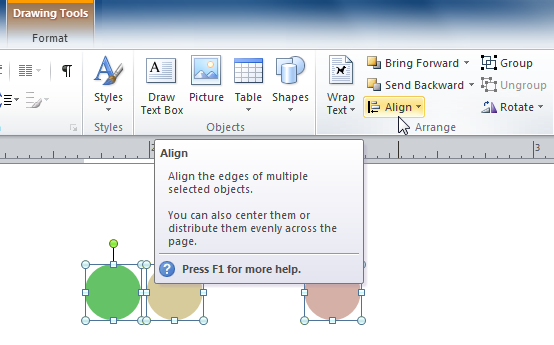 The Align drib-downward control
The Align drib-downward control - From the drib-down carte du jour that appears, select Distribute Horizontally or Distribute Vertically.
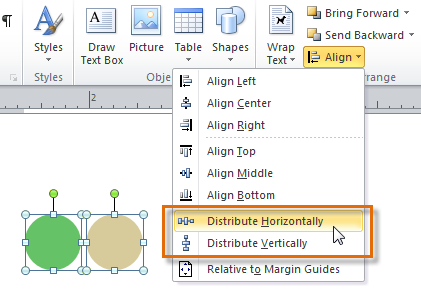 Distribution options
Distribution options - The objects will be distributed evenly.
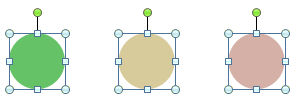 The objects, at present distributed evenly
The objects, at present distributed evenly
Grouping
At times, you may want to grouping multiple objects into ane object and so they will stay together if they're moved. This can be easier than selecting all of the objects each time y'all desire to move them.
To grouping objects:
- Select the objects you wish to group.
- Click the Format tab, then locate the Arrange group.
- Click the Group command.
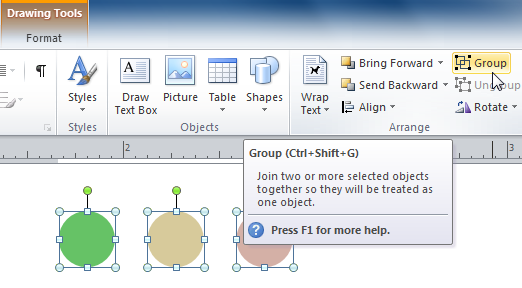 The Group control
The Group control - The selected objects will now be grouped. There will be a single box with sizing handles effectually the entire group to show that they're one object.
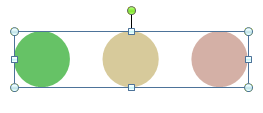 Grouped shapes
Grouped shapes
You can ungroup grouped objects at any time. Simply select the group, then click the Ungroup control.
 The Ungroup command
The Ungroup command
Moving objects backward and forrard
In addition to aligning and group objects, Publisher gives you the ability to accommodate objects in a specific order. Ordering is important when 2 or more than objects overlap, as it will determine which objects are in the front end or the dorsum.
To change the ordering by ane level:
- Select the object y'all wish to move.
- Click the Format tab, then locate the Arrange group.
- Click the Bring Forward or Send Backward command to change the object's ordering by one level. If the object overlaps with more than than one other object, you lot may demand to click the command several times to reach the desired ordering.
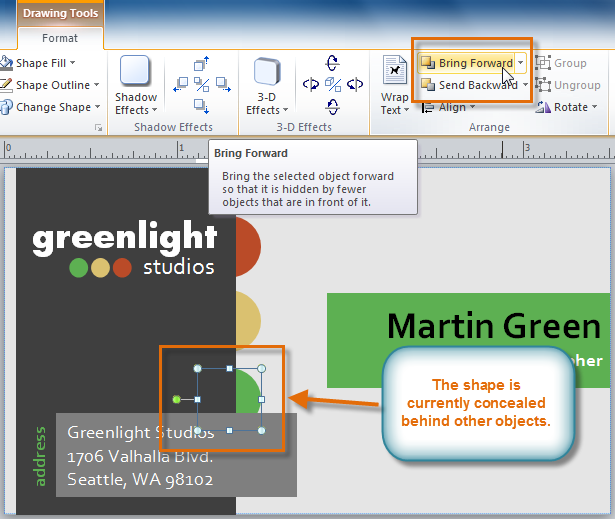 The Bring Forward and Send Backward commands
The Bring Forward and Send Backward commands - The objects will reorder themselves.
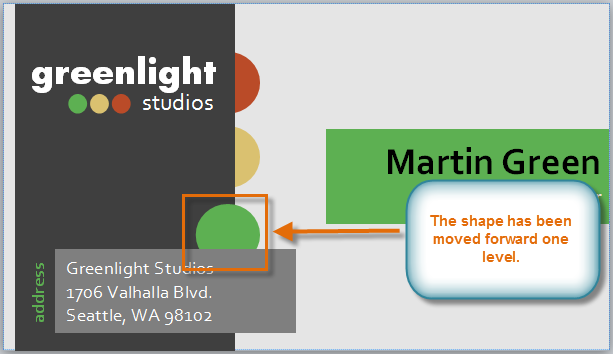 The shape has been moved frontward one level
The shape has been moved frontward one level
To bring an object to the front or dorsum:
If you lot want to motility an object behind or in forepart of several objects, it's usually faster to bring information technology to forepart or send it to back rather than clicking the ordering commands multiple times.
- Select the object y'all wish to motility.
- Click the Format tab, then locate the Adapt group.
- Click the Bring Frontward or Send Astern drib-down command
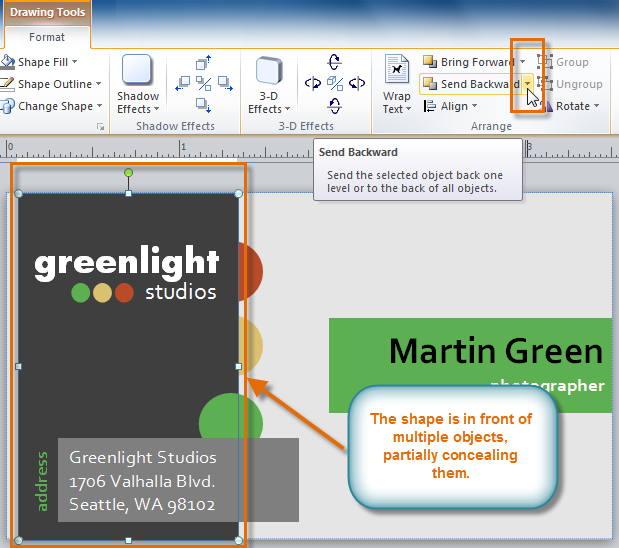 The Bring Forward and Send Astern drop-downwardly commands
The Bring Forward and Send Astern drop-downwardly commands - From the drib-downward menu, select Bring to Front or Send to Dorsum.
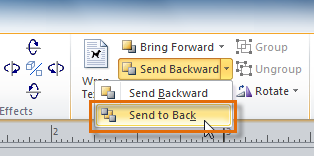 The Send to Back command
The Send to Back command - The objects will reorder themselves.
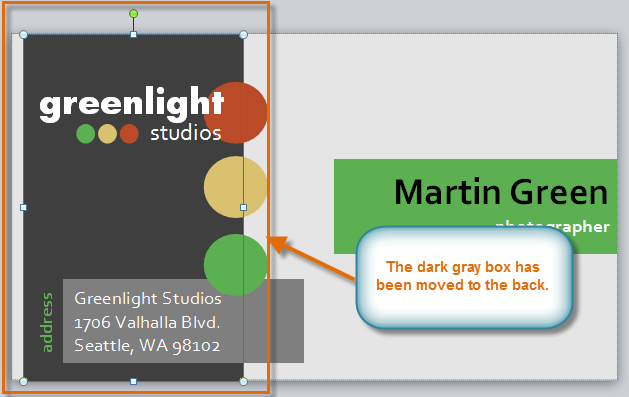 The shape has been moved to the back
The shape has been moved to the back
Challenge!
- Open a publication. If you desire, you lot tin use this example.
- Insert a shape, then rotate it. If you're using the instance, rotate an existing shape.
- Insert another shape, and then change the fill up and outline color of the shape. If you're using the example, add an outline to the light-green box on the front end of the bill of fare.
- Change the guild of the two shapes you inserted. If you're using the instance, select the night gray rectangle on the front end of the card and send it to the dorsum.
- Align ii shapes. If you're using the example, select the green circle and the brackets Edifice Block on the back of the menu and marshal them to middle.
- Group the shapes you just aligned, then align the group to the eye of the folio.
/en/publisher2010/working-with-pictures/content/
Source: https://edu.gcfglobal.org/en/publisher2010/working-with-shapes-and-objects/1/
0 Response to "Why Cant I Wrap Clip Art in a Table Publisher"
Post a Comment